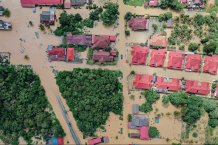articles

Extreme events like floods, heatwaves or droughts often arrive with little or no warning time at all, making effective short-term adaption challenging if not impossible.
High-impact climate events: Better adaptation through earlier prediction
The prediction of high-impact climate phenomena can be substantially improved by a new mathematical approach that analyses the connectivity and patterns between geographical locations, scientists say in a new publication.
This can potentially save thousands of lives and avoid billions in economic losses.
Prediction times for events like El Niño, monsoons, droughts or extreme rainfall could be increased substantially, to a month or in some cases even a year in advance, depending on the type of the event.
The new framework can thus become key for improving adaptation to the global warming crisis.
"The new forecasting approach has, in several instances over the past years, proven to be highly efficient in predicting different climate phenomena much earlier than before," said Josef Ludescher from the Potsdam Institute for Climate Impact Research (PIK), lead author of the perspective article published in the Proceedings of the US National Academy of Sciences.
"El Niño for instance could be predicted up to one full year early, compared to about six months with the standard prediction methods.
"The onset of the Indian Summer Monsoon in central India, vital for the economy in this region, was predicted more than a month in advance, much earlier than the forecast currently used, thanks to the new approach."
Dr Niklas Boers, of the University of Exeter, PIK and TU Munich, said: "The power of network-based foreasting approaches also lies in their generality, making them applicable for different kinds of climate phenomena, from El Niño events to the prediction of both extreme rainfall or droughts.
"For example, six out of the seven most severe Amazon droughts can be predicted using a network encoding the dependencies between the tropical Atlantic ocean and the Amazon."
Extreme events like floods, heatwaves or droughts often arrive with little or no warning time at all, making effective short-term adaption challenging if not impossible.
The new prediction framework fundamentally improves this, as Jürgen Kurths from PIK, a pioneer of network application to climate-phenomena forecasting and co-author of the paper, underlines: "Currently, for instance, there is no reliable prediction of heavy rainfall in the Easter Central Andes leading to floods and landslides with devastating impacts for the inhabitants in that part of South America.
"Our network-based approach can predict those events up to two days in advance – that is crucial time for the people to prepare, save lives and limit damages."
Traditional weather and climate forecasting rely predominantly on numerical models imitating atmospheric and oceanic processes.
These models, while generally very useful, can’t perfectly simulate all underlying processes – and phenomena like monsoon onsets, floods or droughts might be predicted too late.
This is where network-based forecasting comes into play.
Ludescher explains: "As opposed to looking at a huge number of local interactions, which represent physical processes like heat or humidity exchange, we look directly at the connectivity between different geographical locations, which can span continents or oceans.
"This connectivity is detected by measuring the similarity in the evolution of physical quantities like air temperatures at these locations.
"For instance, in the case of El Niño, a strong connectivity in the tropical Pacific tends to build up in the calendar year before the onset of the event."
Kurths adds: "That’s a fundamentally different approach from traditional numerical modelling used in weather and climate forecasts.
"It does not simulate the entire Earth system, but analyses large-scale connectivity patterns in observational data."
Co-author Maria Martin, also at PIK, added: "These patterns, that is the connectivity between the locations and their evolution in time, can provide critical new information for forecasting – and, so we hope, make the respective regions safer.
Hans-Joachim Schellnhuber, former Director of the institute, concludes: “With this perspective, we have brought together several success stories that demonstrate the scientific power of the network approach for forecasting – and, in consequence, for potentially saving thousands of lives and avoiding billions of economic costs."
The article is entitled: "Network-based forecasting of climate phenomena."
Date: 15 November 2021